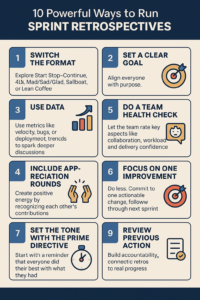Running an effective retrospective (retro) can significantly improve team performance and cohesion. Here are 10 powerful ways to run retrospectives:
1. Start-Stop-Continue
-
How it works: Ask the team to discuss what they should start doing, what they should stop doing, and what they should continue doing.
-
Why it works: This provides clear actionable items and encourages open feedback.
2. 5 Whys
-
How it works: For any issue, ask “Why?” five times (or more) to dig deeper into the root cause of the problem.
-
Why it works: It helps uncover the underlying causes of issues, not just the symptoms.
3. Sailboat Retrospective
-
How it works: Visualize the team as a sailboat with a destination. The team discusses the following:
-

Wind: What helped propel the team forward?
-
Anchor: What slowed the team down?
-
Rocks: What obstacles or risks do we need to watch out for?
-
Island: Where do we want to go next, and how do we get there?
-
-
Why it works: This is a visual and engaging way to discuss progress and challenges.
-
4. Plus/Delta
-
How it works: Use two columns: Plus for things that went well and Delta for things that need improvement.
-
Why it works: It’s simple and helps teams quickly identify what to keep and what to improve.
5. The Hot Air Balloon
-
How it works: Picture the team as a hot air balloon. Discuss:
-
Things that helped us rise (things that went well)
-
Things that are weighing us down (challenges or obstacles)
-
What we need to let go of (to move forward)
-
-
Why it works: It provides a fun, metaphorical way to discuss positives and blockers.
6. Appreciation Round
-
How it works: Begin the retro by asking team members to give each other appreciation. This could be specific praise for behaviors or actions that had a positive impact.
-
Why it works: This sets a positive tone and boosts morale.
7. Timeline Retrospective
-
How it works: Create a timeline of the sprint, release, or project phase, and ask the team to mark events, issues, and highlights along the way.
-
Why it works: This retrospective helps the team visualize their journey, identify pain points, and understand their progress in context.
8. The 4Ls (Liked, Learned, Lacked, Longed for)
-
How it works: Have team members discuss:
-
What they liked
-
What they learned
-
What they lacked
-
What they longed for
-
-
Why it works: It encourages balanced reflection and captures both personal and team-wide insights.
9. Retrospective Poker
-
How it works: Use a deck of cards (or a digital version) with different questions on each card. Each person pulls a card and answers the question, such as “What did we do well?” or “What could we improve?” The team then discusses the answers.
-
Why it works: It adds an element of fun and randomness while still focusing on reflection.
10. Team Health Check
-
How it works: Use a survey or poll to ask the team to rate their satisfaction with various aspects of the project, such as communication, collaboration, tools, and processes. Discuss the results and identify areas for improvement.
-
Why it works: It helps the team reflect on their overall health and focus on improving specific aspects of teamwork.
